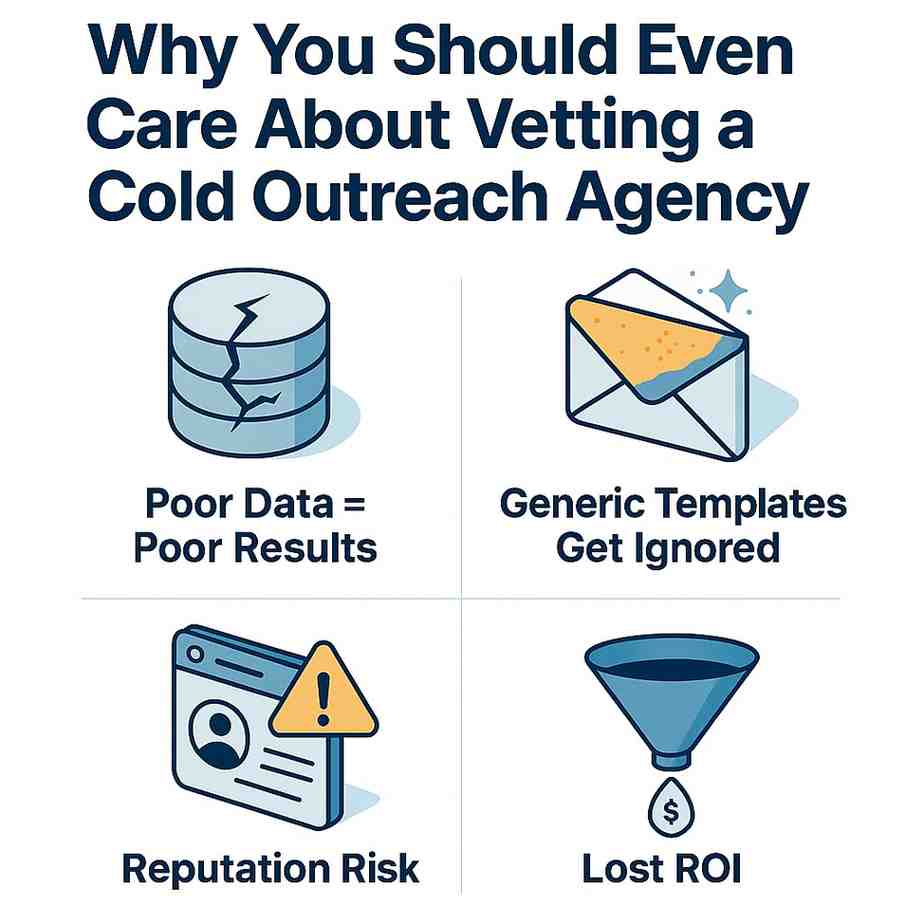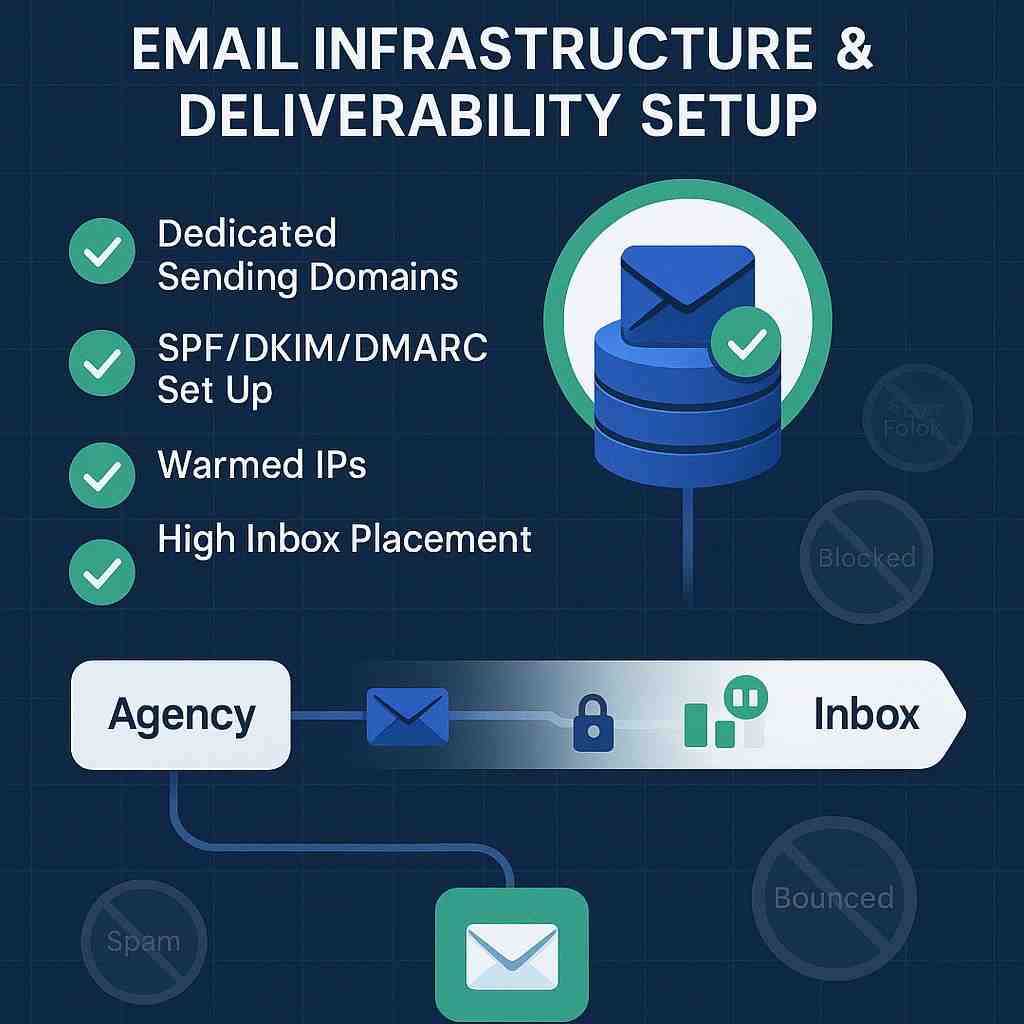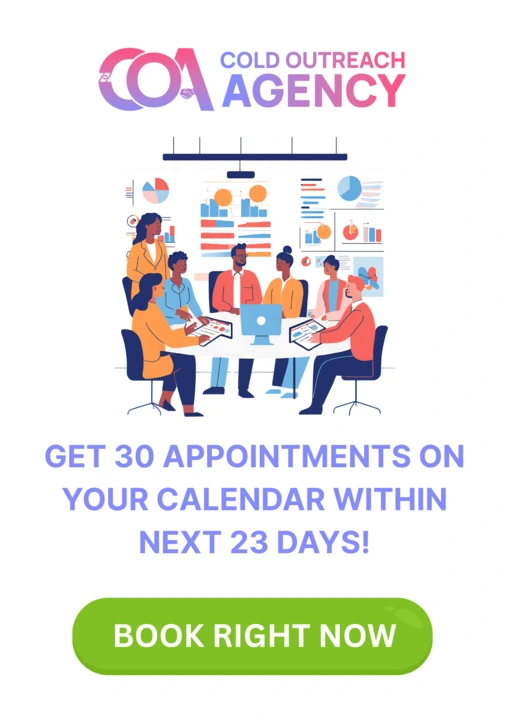If you’re reading this, chances are you’re a business owner, a startup founder, a marketer, or someone who’s been considering hiring a cold outreach agency to take appointment setting or lead generation off your plate. I’ve been there.
Cold outreach is a beast of its own. When done right, it’s a growth lever. When done wrong, it’s a money pit, brand killer, and a spam factory rolled into one. So before you sign on the dotted line and commit your budget and reputation to an agency, you need to vet the hell out of them.
This article is me putting my experience out there—what I’ve learned, what I’ve screwed up, and the exact framework I now use to vet any cold outreach partner. No fluff. No generalizations. Just real talk. Let’s dive in.
First: Why You Should Even Care About Vetting an Cold Outreach Agency

Before I go into the how, let me stress the why. Cold outreach involves direct contact with your potential clients. It’s not some passive marketing strategy. It’s bold. It’s risky. And when someone else is sending messages pretending to be you or your brand, the stakes are high.
Here’s what can go wrong if you don’t vet properly:
Burned domains/IPs from poor email practices.
Damaged brand trust due to spammy or lazy outreach.
Low ROI because they used bad targeting, terrible messaging, or zero personalization.
Missed opportunities because of weak follow-ups or no tracking.
Contract traps with agencies locking you into useless monthly retainers.
So yeah, due diligence isn’t optional. It’s non-negotiable.
Step 1: Get Clear on What You Want First
Before I even reach out to any agency, I take a pause and ask myself:
What’s my offer?
Who exactly is my ICP (Ideal Customer Profile)?
Do I already have working messaging, or do I need them to handle copy too?
What’s my monthly budget and realistic ROI expectations?
Why it matters: If you’re unclear, the agency will fill in the blanks for you, and that’s where most founders get sold generic service packages that never fit.
Step 2: Ask for Case Studies (But Read Between the Lines)
Almost every outreach agency has a “Case Study” section on its site. But here’s the thing—I’ve seen agencies brag about vanity metrics. They’ll show screenshots with “Open rate: 80%” and “Booked 3 calls!”—but fail to give you any business context.
Here’s what I ask for instead:
Who was the client? SaaS? B2B service? Local agency?
What was the offer and target audience?
How long did it take to get results?
What was the channel used—email, LinkedIn, or multi-channel?
How many leads did they reach out to? What was the conversion rate?
Did these leads turn into paying customers?
I also ask: “Can I speak to a past client?” If they say no, red flag. If they say yes, and the client gives you a lukewarm review, bigger red flag.
Here’s what I want to know:
Do they do deep research on each prospect?
Are they using AI tools to scale relevance without sounding robotic?
Do they build custom intros based on pain points, posts, or job roles?
How do they balance volume vs. quality in their personalization strategy?
If they say things like “we use first-name and company-name tokens in our intro,” I walk away. That’s not enough anymore. Real personalization is the difference between “Marked as spam” and “Sure, let’s talk.”
Step 3: Ask How They Source & Qualify Leads
Outreach without quality data is like shooting darts in the dark. So I always ask:
Where do they get their leads from? Scraped from LinkedIn? Built manually?
Do they verify emails before sending? (Hint: if they don’t mention NeverBounce, ZeroBounce, or something similar, they might be hitting invalid addresses.)
How do they match leads to my ICP? Just industry and title? Or more granular?
Do I get to review the leads before campaigns go out?
One big green flag? Agencies that build a custom lead list and give me a sample before launching the campaign. It shows transparency and precision.
Step 4: Investigate Their Email Infrastructure & Deliverability Setup

This one’s huge. Email outreach lives and dies by deliverability. If your emails land in spam, it’s game over—even if your copy is gold.
So here’s what I check:
Are they using smart tools like Instantly, Smartlead, Lemwarm, or Mailreach?
How many emails do they send per inbox per day?
Do they rotate inboxes or just hammer one?
Are they doing proper warm-ups for at least 2 weeks?
I make sure they aren’t just hitting 1,000 inboxes a day from one Gmail domain. That’s a deliverability nightmare waiting to happen.
Step 5: Ask About Reporting, Metrics, and Transparency
If I’m paying someone to run cold outreach, I expect a dashboard or reports showing:
Emails sent
Open rate
Reply rate
Positive reply rate
Call bookings
Bounce rate
Unsubscribes
Blacklist monitoring
Weekly updates are a minimum. If they don’t give visibility into what’s happening, that’s a major problem. Some agencies even charge extra for this data. Nope. That’s part of the service.
Step 6: Review Their Copywriting Quality
Copy is king in cold outreach. Most agencies have average writers who produce robotic, formulaic scripts. I always ask to see samples of actual campaigns (or ask them to mock up a cold email based on my offer).
Here’s what I look for:
Is the intro hook strong?
Are they writing like a human, not a sales bot?
Do they touch on actual pain points?
Is there a real CTA or just “let’s connect” fluff?
Do they use formatting smartly (short sentences, skimmable structure)?
I also test how they adapt their tone based on industry. An outreach script to SaaS founders should not sound like something aimed at restaurant owners.
Step 7: Look Out for Shady Contracts or Red Flags
Before I ever sign, I ask:
Is there a long-term lock-in? (I avoid anything over 3 months unless it’s proven.)
What’s their refund or replacement policy if things flop?
Do I own the data and assets created?
Can I cancel anytime with notice?
Will they show me actual prospect conversations, or just book calls?
Do they charge per lead, per meeting, or flat retainer?
I also look out for shady agencies that outsource everything to low-cost VAs and take a fat cut while delivering subpar results.
If the contract feels overly legal or confusing, I ask myself: Would I be okay taking a hit if this doesn’t work out? If the answer’s no, I don’t sign.
Step 8: Test Before You Scale
Even if everything looks good, I never go all-in from Day 1.
Here’s how I do it:
Start with a 2-week trial or a small 1-month test campaign.
Observe how they communicate during the test: Are they responsive? Transparent? Do they fix issues quickly?
If the results are good and the experience is smooth, then I think about scaling. But I never assume big promises will pan out without proof.
Bonus: Agencies That Specialize in Your Niche Win
There are generalist agencies out there, and then there are niche-focused ones, like those who only work with SaaS startups, agencies, consultants, or even high-ticket B2B services.
In my experience, niche-focused cold outreach agencies perform better because:
They understand industry lingo.
They know what CTAs convert.
They have proven templates, targeting tactics, and data sources.
They’re not testing on your dime.
I always lean toward someone who “gets” my world over someone who promises “we can help everyone.”
My Personal Red Flag List (If They Do This, I Run)
Let me just list out things that are immediate deal-breakers for me:
Agencies that promise guaranteed meetings without explaining how.
Agencies that say “we send 10,000 emails a day.”
No control or visibility over targeting.
No mention of domain warmup or deliverability setup.
Copy that feels like a spammy AI bot wrote it.
No reporting dashboard or weekly updates.
Agencies that ghost mid-project or only communicate when chased.
I’ve lost money and time because I ignored red flags like these. Never again.
Conclusion
Hiring a cold outreach agency is not like hiring a designer or a web developer. You’re not just buying a service—you’re handing someone the keys to your brand’s voice, your sales pipeline, and your first impression in front of your dream clients.
Now that I’ve walked you through the full vetting process—step by step, lesson by lesson—let me bring it all together with something I’ve come to realize over time: choosing the wrong cold outreach agency isn’t just a waste of money… It’s a slow, painful drain on everything that matters—your time, energy, brand, and momentum.
Let me be real here. When I first started working with outreach partners, I made mistakes. Big ones. I said yes too fast. I ignored red flags. I believed the nice salespeople. And I assumed, “They’ve done it for others, they can do it for me.” Spoiler alert: they couldn’t.
So when I say vet deeply, I mean it. Because I’ve lived the consequences of not doing it.
Your Outreach Agency = Your Brand’s First Impression
This is something a lot of people forget. Cold outreach isn’t just another “growth hack.” It’s your first impression. Your agency is out there sending messages under your name, pretending to be you. And that can either build your credibility or destroy it.
If the agency sends a generic copy, your prospects won’t think, “Oh, the agency did a bad job.” They’ll think you’re the one who’s lazy or unprofessional. They won’t see you as a category leader. They’ll see you as another spammy vendor trying to sell something without understanding their world. It comes from experience, strategy, and a process that’s been refined, not improvised.
Why Most Agencies Sound the Same — And Why That’s a Problem
Here’s something I learned the hard way: most outreach agencies look the same on the surface. They say the right things. They flash the same metrics—“25% reply rate!” or “50+ meetings booked for Client X!” They show you shiny dashboards and send pretty proposals.
They spray and pray. And they count any reply as a win.
The truth is, I don’t want volume. I want relevance. I’m looking for operational depth. I want to see their thinking. Their structure. Their intent. And if they don’t have that? I’m out.
Outreach Success Is Never Just About Sending Messages
One of the biggest lies outreach agencies sell is this: “You just need to send more messages, and the calls will come.”
Wrong.
Cold outreach that works is the result of dozens of moving parts working in sync:
- Solid email infrastructure and deliverability setup
- Razor-sharp lead targeting
- Deep, personalized messaging
- Smart sending cadence and channel mix
- A/B testing and iterative improvements
- Human-like tone and relevance
- Proper tracking and conversion attribution
- Timely, relevant follow-ups
You can’t outsource all of this blindly. Even if the agency handles execution, you still need to lead the strategy, the voice, the targeting vision. That’s why I don’t just hire an agency. I collaborate with them. And if they’re not open to collaboration, that’s a dealbreaker.
A Vetting Process Protects More Than Your Wallet
Yes, this whole process is about making sure you don’t waste money. But it’s about more than that.
Vetting properly also protects:
Your brand reputation – so you’re not seen as another spammer in a crowded inbox.
Your time, because every bad lead they send is a sales call you didn’t need to take.
Your morale, because nothing’s more draining than pouring effort into outreach that doesn’t move the needle.
Your opportunity cost – because the time you spend fixing a bad agency’s mess could’ve gone into landing your next dream client.
Every business owner I know who’s scaled with outbound has a horror story or two. But the smart ones learned from those and built airtight vetting checklists. They turned frustration into filters.
Final Advice: Take Your Time, Trust Your Gut, Ask Better Questions. They started with deep conversations. With questions. With mutual alignment.
So take your time. Agencies that are legit welcome scrutiny. They’re proud of their processes. There’ll be alignment. There’ll be trust. There’ll be results.
If You Remember Nothing Else, Remember This:
Vet like your brand depends on it—because it does.
Never outsource blindly.
Look for structure, not just sales talk.
Ask to see real campaign samples, real numbers, and real strategy.
Don’t be afraid to test small and scale slowly.
Own your outcomes—outreach is not a “set it and forget it” game.
But when done wrong, it’s a slow leak in your business—and your reputation.
So vet smart. Take ownership. And don’t settle.
You only get one first impression—make sure the people making it on your behalf are worth it.
So take your time. Ask hard questions. Get into the weeds. Don’t fall for the shiniest case studies or the cheapest quote. But until then, your job is to protect your brand by doing your homework. No shortcuts.
And if an agency doesn’t like being vetted this thoroughly?
Good. They just vetted themselves off your list.

